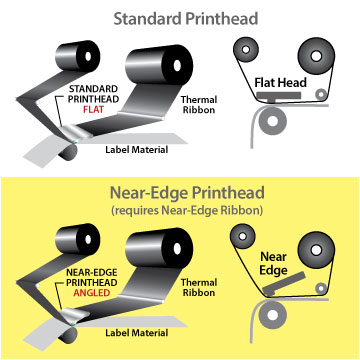Near-Edge Thermal Transfer Printing
Near-edge printing, also referred to as “corner-edge” or “floating head” printing, is a print method that increases print speed and efficiency. The heating elements of the printhead are located at the edge of the printhead, which is placed against the ribbon at an angle. The substrate (tag, label or package) only comes into contact with the ribbon as it passes under the heating elements, shortening the distance between where an image is printed and where the ribbon and receiver separate.
The difference between traditional printing and near-edge printing lies in the printhead’s positioning. With traditional printing, the printhead is placed flat against the ribbon. Near-edge printing, however, uses the “front” or near edge of the printhead to reduce the diode contact area. This greatly increases the print speed and allows you to print the entire width of a label from edge to edge. The minimal printhead contact is also well-suited to printing on synthetic material.
Near-edge ribbons must contain a release layer. This allows the ink to quickly release from the ribbon after melting, without needing to re-solidify. This limits near-edge ribbon types to wax/resin, resin black and color thermal transfer formulations.

- Ribbon and substrate separate instantly after transfer melting
- Can print thick substrates – up to 14 point card stock
- Very fast speed up to 40+ inches per second (IPS) of high-speed, flexible packaging printers. Tabletop printers 14+ IPS
- Features a ribbon saver, which stops the ribbon during the printing process when printing is not needed and cuts down on wasted ink
- Black and color (monochrome) ribbons are available
For more information or to discuss your project, Contact Us or call 888-237-8525.


